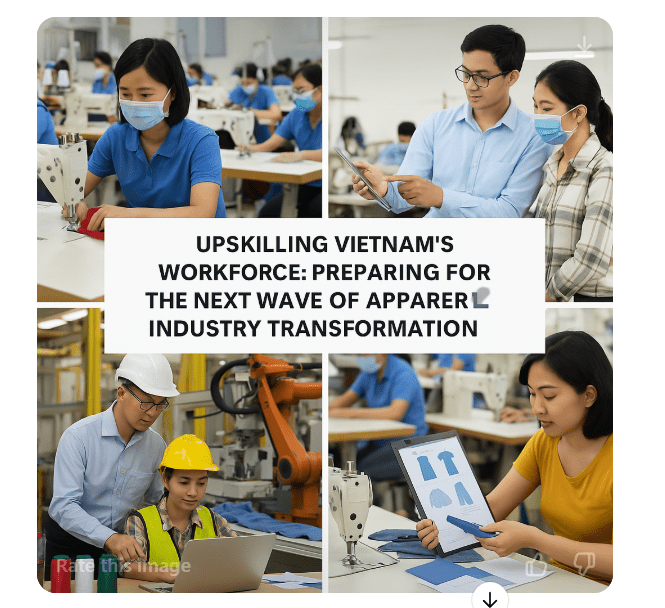Introduction
Vietnam’s apparel industry is a global manufacturing leader, employing millions and driving economic growth. However, automation, sustainability, and shifting global demands require a more skilled workforce. To stay competitive, Vietnam must prioritize upskilling, equipping workers with digital, technical, and sustainable expertise to enhance efficiency and innovation.
Global Trends in Apparel Industry Workforce Development
The global apparel industry is witnessing transformative changes:
Digital and Automated Manufacturing: Automation and AI-driven production are reducing manual labor dependency while increasing efficiency.
Sustainability and Ethical Manufacturing: Compliance with eco-friendly processes and ethical labor practices is driving skill demand.
Skill Gaps: The apparel workforce worldwide lacks expertise in digital production, robotics, and sustainable practices.
Lessons from Global Leaders: Countries like Bangladesh and China have successfully integrated workforce training initiatives, offering a roadmap for Vietnam.
Current State of Vietnam’s Apparel Workforce
Workforce Demographics: Vietnam’s apparel industry employs over 2.5 million workers, a majority of whom lack advanced technical skills.
Skill Deficiencies: A shortage of expertise in automation, fabric technology, and compliance with sustainability standards hampers industry growth.
Training Gaps: Limited technical and vocational education leaves workers unprepared for Industry 4.0 changes.
Success Stories: Some factories have begun adopting digital training modules with positive productivity outcomes.
Essential Skills for the Future of Vietnam’s Apparel Industry
Technical Skills: Advanced garment construction and fabric technology.
Digital and Automation Proficiency: AI, ERP systems, and robotics are becoming integral.
Sustainability Knowledge: Eco-friendly material use and compliance with global standards.
Soft Skills: Adaptability, leadership, and workforce management.

Vu Duc Giang
Chairman (VITAS)
“We need to step up chain connectivity, from material and machinery to marketing, and to optimize technologies an artificial intelligence to improve productivity and quality, and create product uniqueness.”
Strategies for Workforce Upskilling
Industry-Led Training: Collaborations between manufacturers and training institutions.
Government Initiatives: Strengthening TVET (Technical and Vocational Education and Training) for apparel-specific skills.
Technology-Integrated Learning: E-learning platforms and VR simulations for hands-on training.
Brand Partnerships: Buyer-supported training programs to meet global compliance and quality expectations.
Impact of Upskilling on Productivity and Cost Optimization
Efficiency Gains: Skilled workers enhance production speed and minimize downtime.
Quality Improvement: Reduced defects lower operational costs.
Workforce Retention: Higher job satisfaction decreases turnover rates.
Cost Reduction: Investment in upskilling results in long-term operational savings.
The Role of Groyyo in Workforce Development
Groyyo is pioneering workforce upskilling initiatives by integrating technology with training:
AI-Driven Training Modules: Personalized learning paths based on worker capabilities.
Digital Learning Platforms: E-learning solutions enable remote skill development.
Smart Factory Integration: Upskilling workers in automation and AI-driven apparel production.
Real-Life Success: Groyyo has implemented AI-powered efficiency tracking, reducing errors by 30% in partner factories.
Future Plans: Expansion of training programs to upskill 100,000 Vietnamese apparel workers by 2025.
Policy Recommendations for Workforce Development
Government Incentives: Tax benefits for companies investing in workforce upskilling.
TVET Strengthening: Aligning training curriculums with industry needs.
Long-Term Roadmap: Strategic workforce development policies ensuring sustainability.
Roadmap for Vietnam’s Apparel Workforce Transformation
Short-Term Goals: Bridging immediate skill gaps through digital training.
Long-Term Strategy: Establishing Vietnam as a hub for skilled apparel manufacturing talent.
Metrics for Growth: Workforce efficiency assessments to gauge upskilling impact.
Conclusion
The future of Vietnam’s apparel industry relies on a highly skilled workforce equipped with digital, technical, and sustainability expertise. Collaboration among industry leaders, government, and educational institutions is crucial. Groyyo’s role in this transformation ensures that Vietnam remains a global leader in apparel manufacturing, fostering innovation, efficiency, and sustainability in the sector. The time for action is now—Vietnam must embrace workforce upskilling to sustain its position in the global apparel market.

Divya Mohan
General Manager (International Business)
divyamohan@groyyo.com


Leave a Comment